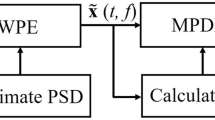Abstract
On-line adaptive learning algorithms for cancellation of additive, convolutive noise from linear mixtures of sources with a simultaneous blind source separation are developed. Associated neural network architectures are proposed. A simple convolutive noise model is assumed, i.e. the unknown additive noise in each channel is a (FIR) filtering version of environmental noise, where some convolutive reference noise is measurable. Two approaches are considered: in the first, the noise is cancelled from the linear mixture of source signals as pre-processing, after that the source signals are separated; in the second, both source separation and additive noise cancellation are performed simultaneously. Both steps consist of adaptive learning processes. By computer simulation experiments, it was found that the first approach is applicable for a large amount of noise, whereas in the second approach, a considerable increase of the convergence speed of the separation process can be achieved. Performance and validity of the proposed approaches are demonstrated by extensive computer simulations.
Similar content being viewed by others
Explore related subjects
Discover the latest articles, news and stories from top researchers in related subjects.Abbreviations
- Symbol :
-
Meaning
- κ 4 :
-
normalised kurtosis of a signal
- η(t),\(\tilde \eta \) t :
-
learning rates
- m :
-
number of sources
- n :
-
number of sensors
- N,M :
-
order of the FIR filters
- s(t) :
-
m-dimensional vector of (unknown) source signals
- x(t) :
-
n-dimensional vector of mixed signals (sensors)
- y(t) :
-
n-dimensional vector of separated output signals (estimated sources)
- v R(t):
-
(unknown) primary environment noise signal
- n R(t):
-
secondary reference noise signal
- n(t) :
-
n-dimensional vector of additive noise signals
- f(·),g(·) :
-
activation functions in separation rule
- f R(·):
-
activation function in noise cancellation rule
- A=[a ij]m×n :
-
(unknown) mixing matrix
- B=[b ij]n×N :
-
additive noise generation matrix
- H(t)=[h ij]n×M :
-
noise cancellation matrix
- W(t)=[w ij]n×n :
-
global de-mixing matrix
References
Amari S-I, Cichocki A, Yang HH. A new learning algorithm for blind signal separation. In: Neural Information Processing Symposium (NIPS'95), vol 8, MIT Press, Cambridge, MA, 1996; 757–763
Amari S-I, Cichocki A, Yang HH. Recurrent neural networks for blind separation of sources. In: Proc NOL-TA'95, Tokyo, Japan, 1995, 37–42. NTA Research Society of IEICE
Cichocki A, Amari S, Adachi M, Kasprzaak W. Selfadaptive neural networks for blind separation of sources. In: 1996 IEEE Int Symposium on Circuits and Systems, (ISCAS'96), vol 2, 1996; 157–160. IEEE
Oja E, Karhunen J. Signal separation by nonlinear hebbian learning. Computational Intell 1995: 83–96
Cardoso JF, Belouchrani A, and Laheld B. A new composite criterion for adaptive and iterative blind source separation. In: Proc ICASSP-94, vol 4, 1994: 273–276
Bell AJ, Sejnowski TJ. An information-maximization approach to blind separation and blind deconvolution. Neural Computation 1995; 7: 1129–1159
Jutten CL., Herault J. Blind separation of sources, part i: An adaptive algorithm based on neuromimetic architecture. Signal Process 1991; 24(1): 1–10
Cichocki A, Kasprzak W, Amari S. Multi-layer neural networks with a local adaptive learning rule for blind separation of source signals. In: Int Symposium on Nonlinear Theory and its Applications (NOLTA'95), Tokyo, Japan, 1995; 61–65. NTA Research Society of IEICE
Van Gerven S. Adaptive Noise Cancellation And Signal Separation with Applications to Speech Enhancement. Dissertation, Katholieke Universiteit Leuven, Departement Elektrotechnik, Departement Elektrotechnik, Leuven, Belgium, 1996
Van Gerven S, Van Compernolle D, Nguyen-Thi HL, Jutten C. Blind separation of sources: A comparative study of a 2-nd and a 4-th order solution. In: Signal Processing VII, Proc EUSIPCO-94, Lausanne, Switzerland, 1994: 1153–1156. EUSIP Association
Cichocki A, Kasprzak W, Amari S. Adaptive approach to blind source separation with cancellation of additive and convolutional noise. In: Third Int Conf Signal Processing (ICSP'96), vol I, China, October 1996: 412–415. IEEE Press/PHEI Beijing
Windrow B, Stearns SD. Adaptive Signal Processing, Prentice-Hall, Englewood Cliffs, NJ, 1985
Cichocki A, Unbehauen R. Neural Networks for Optimization and Signal Processing John Wiley & Sons, New York, 1994
Haykin S (ed.). Blind Deconvolution, Prentice-Hall, Englewood Cliffs, NJ, 1994
Author information
Authors and Affiliations
Corresponding author
Rights and permissions
About this article
Cite this article
Kasprzak, W., Cichocki, A. & Amari, S. Blind source separation with convolutive noise cancellation. Neural Comput & Applic 6, 127–141 (1997). https://doi.org/10.1007/BF01413824
Issue Date:
DOI: https://doi.org/10.1007/BF01413824




